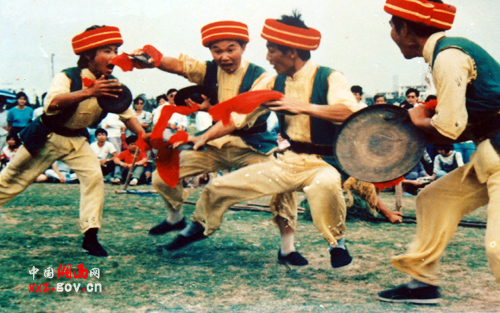 |
| Tian Longxin [Filephoto/ xxz.gov.cn] |
Collecting Tujia Folk Art
Tian had his dream job, but he was performing a dying art. Many Tujia artists died without passing on their skills to future generations. Dismayed at the art’s decline, Tian decided to pass on his teachers’ talents and thereafter started to collect and catalogue everything he could find about the local folk art.
Collecting information was never easy. As there was no transportation, Tian had to walk from village to village carrying an old backpack to visit local folk artists. Many lived in secluded villages, across high mountains and dense forests. He often spent a whole day travelling for an evening interview. Sometimes Tian had to make several trips to visit one artist. After collecting data, Tian also had to catalog and compile their stories as well as record musical notes, all by the light of a flickering kerosene lamp.
In this way he visited over 100 folk artists, collecting over 230 folk songs and writing more than 2.6 million characters about local operas and other performances. With these materials, Tian was able to cooperate with other professionals on editing three books: Folk Music Collection of Xiangxi Tujia and Miao Autonomous Prefecture, Chinese Folk Vocal Art – Collection in Longshan County and Chinese Folk Instrumental Music – Collection in Longshan County of Hunan Province.
Writing New Folk Songs
During his decades-long musical career, Tian’s preferred musical form was the Daliuzi, an instrumental ensemble of four percussion instruments, recognized in 2006 as part of China’s intangible cultural heritage. It took several tries before Tian figured out the best way to present the haunting tones of this ancient folk art. One day, he dreamed that he was a young cowboy listening to the crowing of golden pheasants. When he awoke, Tian felt a sudden surge of creative inspiration. The grace and elegance of the golden pheasant came to represent Tian’s vision of Tujia music, and he used the bird’s image as the theme of local folk music. He wrote a new Daliuzi melody, Romping Golden Pheasants, in which four instruments reflect different scenarios of the golden birds as they romp, strut and fight.
Romping Golden Pheasants was a critical success and highly acclaimed by audiences. It has also been selected as a representative of Chinese folk percussion music and toured the world. In 1985, Romping Golden Pheasants was selected by the Central Conservatory of Music as a masterpiece of Chinese percussion and performed in Germany, Italy, Switzerland and the Netherlands. In 1986, the Conservatory’s folk music troupe performed it in the United States. In 1993, the song was performed by the Chinese Percussion Music Troupe at a world percussion festival in Berlin. Audiences said that they had never imagined cymbals being played in so many ways.
Today, Romping Golden Pheasants has been recognized as “Influential Chinese Folk Music at Home and Abroad” by the Central Conservatory of Music and is regarded as a classic of Tujia and Chinese music. In 2012, the Conservatory launched a Tujia Daliuzi class and invited Tian as a lecturer.
Over the past decade, Tian has performed over 100 times at important art events at home and abroad. He has also organized a Tujia folk band with three other Daliuzi players. Now 73, Tian says that Tujia folk music is his lifelong career!
